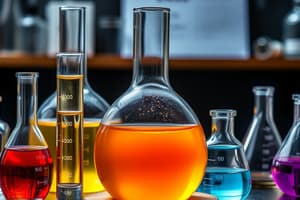Podcast
Questions and Answers
Match the following biological processes with their primary function:
Match the following biological processes with their primary function:
Photosynthesis = Conversion of light energy into chemical energy Cellular Respiration = Breakdown of glucose to produce ATP Mitosis = Cell division for growth and repair Meiosis = Production of gametes for sexual reproduction
Match the following chemical compounds with their common uses:
Match the following chemical compounds with their common uses:
Sodium Chloride (NaCl) = Table salt and food preservation Sulfuric Acid (H2SO4) = Production of fertilizers and industrial processes Ammonia (NH3) = Fertilizers and cleaning agents Methane (CH4) = Fuel and energy production
Match the layers of the Earth with their primary composition:
Match the layers of the Earth with their primary composition:
Crust = Solid outermost layer composed of rock Mantle = A mostly-solid rocky layer between the crust and the core Outer Core = A liquid layer made of iron and nickel Inner Core = A solid sphere made of iron and nickel
Match the physics concepts with their definitions:
Match the physics concepts with their definitions:
Match the astronomical objects with their descriptions:
Match the astronomical objects with their descriptions:
Match the cellular organelles with their functions:
Match the cellular organelles with their functions:
Match the types of chemical reactions with their descriptions:
Match the types of chemical reactions with their descriptions:
Match the terms related to weather with their meanings:
Match the terms related to weather with their meanings:
Match the physics terms related to electricity with their meanings:
Match the physics terms related to electricity with their meanings:
Match key Astronomy events with the stages of star development
Match key Astronomy events with the stages of star development
Flashcards
What is Science?
What is Science?
A systematic approach to understanding the natural world through observation, experimentation, and analysis.
Cell Theory
Cell Theory
States all living organisms are composed of cells, the basic units of life.
Gene Theory
Gene Theory
Traits are inherited through genes on chromosomes made of DNA.
Homeostasis
Homeostasis
Signup and view all the flashcards
Evolution
Evolution
Signup and view all the flashcards
What is Chemistry?
What is Chemistry?
Signup and view all the flashcards
Periodic Table
Periodic Table
Signup and view all the flashcards
Chemical Bonding
Chemical Bonding
Signup and view all the flashcards
Thermodynamics
Thermodynamics
Signup and view all the flashcards
What is Earth Science?
What is Earth Science?
Signup and view all the flashcards
Study Notes
Science
- Systematic and organized approach used to understand the natural world through observation, experimentation, and analysis.
- Encompasses various disciplines, each addressing different aspects of the universe.
- The main goal is to develop explanations, or theories, that accurately describe and predict natural phenomena.
- Relies on the scientific method, involving observations, hypotheses, experiments, and conclusions.
- Characterized by reliance on empirical evidence, logical reasoning, and skepticism.
- Scientific knowledge evolves as new discoveries refine or replace existing theories.
- Technology applies scientific knowledge for practical purposes, leading to human-benefiting innovations.
- Science addresses global challenges like climate change, disease prevention, and resource management.
- Interdisciplinary collaboration is increasingly important due to the multifaceted nature of complex problems.
- The communication of scientific findings disseminates knowledge and informs public policy.
Biology
- The scientific study of life and living organisms.
- Explores the structure, function, growth, origin, evolution, and distribution of living things.
- Key concepts include cell theory, gene theory, homeostasis, and evolution.
- Cell theory: All living organisms consist of cells, the basic units of life.
- Gene theory: Traits are inherited through genes, located on chromosomes and made of DNA.
- Homeostasis: An organism's ability to maintain a stable internal environment despite external changes.
- Evolution: The process by which populations of organisms change over time.
- Major branches include botany (plants), zoology (animals), microbiology (microorganisms), and ecology (organism-environment interactions).
- Genetics studies genes, heredity, and genetic variation in living organisms.
- Biotechnology applies biological knowledge to develop technologies and products like pharmaceuticals and genetically modified crops.
- Conservation biology focuses on protecting biodiversity and ecosystems.
- Biological study includes using microscopes, genetic sequencing, and computational modeling.
- Ethical considerations are important in biological research, especially in genetic engineering and animal experimentation.
Chemistry
- Study of matter and its properties, and how matter changes.
- Explores the composition, structure, properties, and reactions of atoms, molecules, and compounds.
- Key concepts include the periodic table, chemical bonding, chemical reactions, and thermodynamics.
- The periodic table organizes elements based on atomic structure and properties.
- Chemical bonding involves attractive forces holding atoms together to form molecules or compounds.
- Chemical reactions rearrange atoms and molecules, forming new substances.
- Thermodynamics studies the relationships between heat, energy, and work in chemical and physical processes.
- Major branches include organic (carbon compounds), inorganic (non-carbon compounds), physical (physical principles of chemical phenomena), analytical (composition of matter), and biochemistry (chemistry of living organisms).
- Stoichiometry is the quantitative study of relationships between reactants and products in chemical reactions.
- Kinetics studies reaction rates and the factors influencing them.
- Electrochemistry studies the relationship between chemical reactions and electrical energy.
- Chemical principles are applied in industries like pharmaceuticals, materials science, and environmental science.
- Chemistry develops new materials like polymers, ceramics, and nanomaterials.
Earth Science
- Study of the Earth, its structure, processes, and history.
- Includes geology, oceanography, meteorology, and environmental science.
- Geology studies the Earth's physical structure, substance, history, and processes.
- Oceanography studies the Earth's oceans' physical, chemical, and biological properties.
- Meteorology studies the Earth's atmosphere and weather patterns.
- Key concepts include plate tectonics, the rock cycle, climate change, and the water cycle.
- Plate tectonics explains the movement of the Earth's lithosphere, causing earthquakes, volcanoes, and mountain formation.
- The rock cycle describes how rocks are formed, altered, and destroyed.
- Climate change refers to long-term changes in Earth's climate, mainly caused by human activities.
- The water cycle describes the continuous movement of water on, above, and below the Earth's surface.
- Environmental science focuses on human-environment interactions, including pollution, conservation, and resource management.
- Paleontology studies prehistoric life, including fossils and ancient environments.
- Seismology studies earthquakes and seismic waves.
- Earth science helps understand natural hazards and develops mitigation strategies.
Physics
- Study of matter, energy, and their interactions.
- Explores the fundamental laws governing the universe's behavior.
- Key concepts include mechanics, thermodynamics, electromagnetism, and quantum mechanics.
- Mechanics deals with the motion of objects and the forces that cause them.
- Thermodynamics deals with heat, energy, and their transformations.
- Electromagnetism deals with interactions between electric and magnetic fields.
- Quantum mechanics studies the behavior of matter and energy at atomic and subatomic levels.
- Major branches include classical mechanics, electromagnetism, optics, acoustics, nuclear physics, and particle physics.
- Relativity, developed by Albert Einstein, describes the relationship between space, time, gravity, and the universe.
- The standard model of particle physics describes the fundamental particles and forces in the universe.
- Astrophysics applies physics to study celestial objects and phenomena.
- Condensed matter physics explores the properties of solids, liquids, and other forms of matter.
- Physics develops new technologies, such as lasers, semiconductors, and medical imaging devices.
- Mathematical modeling describes and predicts physical phenomena.
- Experimental physics tests theoretical predictions and discovers new phenomena through designed experiments.
Astronomy
- Scientific study of celestial objects (stars, planets, galaxies, nebulae).
- Explores the origin, evolution, and properties of the universe.
- Key concepts include cosmology, astrophysics, and planetary science.
- Cosmology studies the origin, evolution, and structure of the universe.
- Astrophysics applies physics to study celestial objects' properties and behavior.
- Planetary science explores the formation, composition, and characteristics of planets and other bodies in our solar system.
- Major study areas include stellar evolution, galaxy formation, and the search for extraterrestrial life.
- Telescopes are essential for observing celestial objects and phenomena.
- Spectroscopy analyzes light emitted or absorbed by celestial objects to determine their composition, temperature, and velocity.
- Space missions enable close-up studies of planets, moons, and other objects.
- Black holes are spacetime regions with gravity so strong that nothing, including light, can escape.
- Dark matter and dark energy are mysterious components making up most of the universe's mass and energy.
- The Big Bang theory describes the universe's origin as an expansion from an extremely hot and dense state.
- Astronomy is continuously evolving, with new discoveries made regularly.
Studying That Suits You
Use AI to generate personalized quizzes and flashcards to suit your learning preferences.




